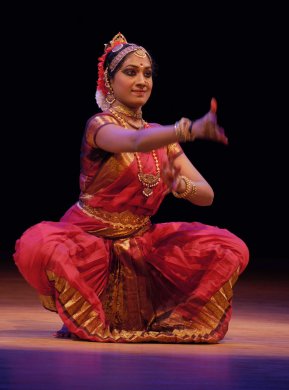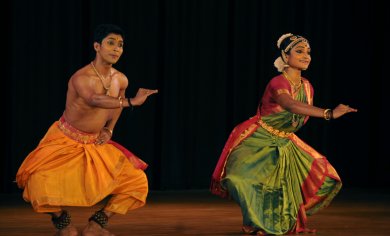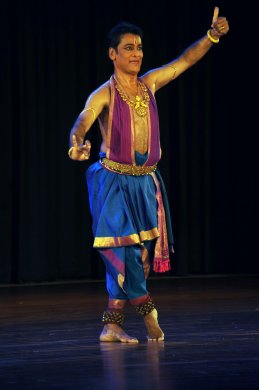
|   |

|   |
The Madras Music Academy Dance Festival - Day 7 - Veejay Sai e-mail: vs.veejaysai@gmail.com Photos: Thanthoni January 28, 2017 Finally, some quality Kuchipudi! Kuchipudi is a fading dance form. The simple fact that in the whole country and outside, we barely have a handful of young talented dancers who will perform it the way it needs to be is a witness to this. We don't have as many Kuchipudi dancers as we have in Bharatanatyam and even Mohiniattam. Among the youngsters who are up and coming, Delhi-based T Reddi Lakshmi's name is easily one of the top ten in our country now. Having trained with different gurus earlier, she currently gets guidance from Guru Jayarama Rao. This was Lakshmi's debut at the Academy's festival and in Chennai.  Lakshmi opened her performance with a composition of Tallapaka Annamacharya "Vandeham jagat vallabham." Set to tune by Nedunuri Krishnamurty in ragam Hamsadhwani and khanda chapu talam, this Sankeertana became very popular on the concert stage, more than in dance. Choreographed by Jayarama Rao, the sahityam explored various episodes from the Vishnu leelas. Be it the Kurma Avataram in the charanam 'Mandara Dhara' or the episode of Rama killing demons Maricha and Subahu in the charanam 'Rama Namam,' the choreography was original in its attempt and Lakshmi gave it the best. One would have liked to see more of the lively Kuchipudi hand work though. She continued her performance with an excerpt from the famous Bhama Kalapam. In "Siggayenoyamma," Satyabhama tells her sakhi Madhavi the beauty of Krishna with top to toe descriptions. Set to a series of melodious ragams like Ananda Bhairavi, Madhyamavati, Athana and more, the whole sequence is charming when performed in the dramatic style. All was fine here except when Guru Jayarama Rao decided to take on the role of Madhavi! The Madhavi in this performance was actually a Madhava! It was a bit odd to hear a robust male voice coyly ask questions like a Sakhi! Lakshmi must also write down a script when announcing to avoid bloopers. She kept talking about "Mukku Mungera," basically a nose stud. But the description of the sequence got everyone confused. The third piece was a Meera bhajan "Mai saavre rang raachi" set to Desh ragam. The mood was set by the melodious jugalbandi of Shruti Sagar's flute and K.P. Nandini's violin. The song is a well-known one and doesn't need much description. A bit over dramatized in Lakshmi's choreography where Meera is choking over the poison given to her by Rana. The javali "Muttavaddura mohananga" is about the khandita nayika upset with her lover's ways. Lakshmi once again announced "The nayika says 'Dare you not touch me!' to her lover", instead of "you dare not touch me!", having the hall in splits. The meaning was completely changed in the announcement. Some of these bloopers could have easily been avoided had Lakshmi either written down a script or got a friend to do the announcements. The choreography showed the sarcasm in the nayika. What is a good Kuchipudi performance without a signature Tarangam? The final piece of her performance was a Narayana Theertha Tarangam "Shiva shiva bhava bhava." Lakshmi exhibited her virtuosity of pada bhedas and sancharas on the brass plate. Satish Venkatesh's melodious singing enhanced the performance further. Lakshmi is easily one of the best Kuchipudi soloists we have today. It might be a blessing to her and her career that she lives in Delhi, far from the politics of the mainstream Andhra land and Telugus. Her debut at the Academy festival was impressive and showed great promise in the coming years. In sync with their art Bharatanatyam is full of dancing couples. This is not a new trend at all. From the veteran lot of dancers like C.V. Chandrashekar and his wife Jaya, V.P. Dhananjayan and his wife Shanta, Narasimhachari and Vasantalakshmi to the later batches of dancing couples, this has been a long standing development. Among all the couples, very few of them can break out into solo performers of good merit. One is always balancing the other in a performance or in the choreography. While this kind of dependence seems charming, it can soon lead to creative stagnation. Several couples have ended up that way. But among the new age couples, if there is anyone that comes with a great freshness in energy and performance it is Renjith Babu and Vijna Vasudevan.  They opened their performance with a sollu-heavy Pushpanjali 'Thajonn Thadhimi Thaka' set to ragam Nagaswarawali and adi talam, a composition of K Balakrishnan who was also accompanying them on nattuvangam. The main piece was "Rave Himagiri Kumari" the famous Shyama Sastri swarajati in ragam Todi. This was preluded by a sloka from Adi Shankara's Soundaryalahiri "Shive Shringarardhra" that describes the compassion in the eyes of the mother goddess. Ramprasad's melodious vocals rendered the sloka in a Grihabhedam and returned to Todi, a quick one that could have almost gone unnoticed. At this point I must mention it was an idea the dancers and I were thinking of for over a year. The ideas of the choreography was completely their own. The Swarajati is a complicated one. The composer doesn't delve much into stories except for the fact that he is a subject who is requesting the goddess for her motherly compassion. Added to all this was the justice one had to do with a heavyweight ragam like Todi. With great efforts Renjith and Vijna utilized their choreographic skills to literally tame this composition to suit dance vocabulary. A feat in its own! Using subtle but efficient sancharis, be it a majestic Gaja Gamanam, the stride of an elephant, or simple stories, the choreography fit in the flow of thought that the composition demanded. The jatis were executed with precision. Ramprasad who began the vocals melodiously seemed to tire out with a fatigued voice towards the end of this piece. Overall it was great attempt and with some more reworking it can be polished further. This was followed by a javali "Appadurukulonaithine," a composition of Thirupanandal Pattabhiramayya set to ragam Khamas and adi talam. Performed as a solo by Renjith, who played the role of a nayika, it was refreshing to watch his choreography around it. Renjith doesn't make for the best of nayikas as his mukhaja abhinayam needs much more expressive reworking. However, he managed to pull this number off with much charm and ease. The next was a solo by Vijna. Kshetrayya's padam "Ninnu joochi" set to ragam Punnagavarali and trisra triputa talam had Vijna play a different nayika. Here she remembers her lover who went away and returned to a home that has changed over the years. A child who grew up while he was away and how life moved on contained the pathos of the nayika's bhaavam. With a few changes in the choreography, it could be bettered. Some of the abhinayam didn't match the poetic lyrics of Kshetrayya. But in these two solos we knew how both of these dancers made for individual strong soloists as well. The last piece of their presentation was a joyful rendering of a traditional Hori composed by Pt Ratanjankar. "Holi khelan ko chale Kanhaiya" is a common number among Kathak dancers. With a different kind of choreography, this Hori got a new lease of life. Vijna playing the nayika and Renjith playing Krishna, frolicking in Holi colours as the rest of Braj celebrates was portrayed with great bonhomie. If you had to see the Yoga practitioner side of Renjith, the choreography of this piece had him reveal it in small measures. With immense control over his body, as Renjith performed a full circle on the floor in one scene where the Pichkari of colours is thrown over him, he was received with applause. The piece ended with both of them playing Holi and drenching the land of Braj in divine colours. Their performance received a standing ovation from an unusually packed audience for a mid-morning show. Both Renjith and Vijna are dancers of high merit, and when they perform as a duet, they are a delight to watch. This year's Academy performance was one of the best they gave. A stage caught in Cupid's quiver  The last day's evening slot opened with a solo performance of A. Lakshmanswamy. For those who have seen him performing in the same festival on an earlier occasion, his rendering of the famous Husseini Swarajati continues to rule! Lakshman opened his performance with a slokam that continued into a traditional alarippu set to chatushra talam. While this might have helped Lakshman to warm up suitably for the next long main piece, what it contained was the charm of old world performance. Though a little ungainly in his stature with a multi-coloured aaharyam and big chunky jewelry, one cannot say Lakshman was unaesthetic in his presentation. The nidaanam that one would expect from a traditional Bharatanatyam performance grew slowly on its audiences. This mood was further enhanced in the famous Manduka Sabdam composed by Melattur Kasinathayya. There are various versions of the sabdam and all of them are pleasurable to watch. Considering the sabdam itself has been phased out of a Bharatanatyam performance nowadays, this was refreshing. The main piece for the evening was the pada varnam "Nee saatidora" by Ponnaiah Pillai of the Thanjavur Quartet. Set to ragam Bhairavi and rupaka talam this is a fairly complicated and long piece. One is the sahityam and the other level is rendering the emotional depth of a ragam like Bhairavi. The nayika here says "Eevela naa saami nenaruncha raa" pleading with the lover to heed to her words now. Talking about how she is being pierced by the arrows of Manmadha, we saw the nayika pining for her lover singing "Maarudidigo vochchera ne taalalenura." The choreography of the varnam was exceptional and the nayika portrayed by Lakshman a dream to watch aided by Aadith Narayanan's nattuvangam and Nellai Kannan's mridangam. By the end of the long unwinding varnam as the nayika kept getting hit by cupid's arrows, we saw the entire stage covered with endless arrows. If they were real, Lakshman would have had to take them in a truckload after his performance! The beauty of the varnam is that it can be explored on and on, without knowing time. This is exactly what Lakshman did. Having cut out three other pieces mentioned in the brochure in his performance, he stayed caught in the varnam for longer than anyone else could. While the theme of the varnam itself was stagnant, Lakshman's execution in his sancharis and nritta kept the flow going without making it seem tedious. Artistes like Lakshman can go on for hours in a traditional varnam. Any amount of time slot falls short for their artistry. Lakshman continued his performance with a Jayadeva ashtapadi "Priye Charusheele." While this is a known ashtapadi and Lakshman's choreography portrayed the khandita nayika in the composition, it was difficult to get out of the earlier nayika from his varnam. The varnam hijacked Lakshman's performance. It was brilliant but one wishes he had a sense of proportion and time management in a performance of this nature. It was a well-laid out buffet out of which the rasikas were constantly fed only one dish. The consistent spectacle The grand finale of the Academy's festival was by the excellent dancers of Nrityagram. For several years now they have been consistently providing a grand spectacle of a finale to the festival. This year too they didn't fall short of any expectations.  They opened their performance with a solo by Bijayini Satpathy. Dancing to "Jai Sankha Gadhadhara Nilapadam, Patapitambara Dehipadam...," Bijayini welcomed auspicious energies and blessings of the patron god of all Odissi performances, lord Jagannath of Puri. In the following piece titled 'Aakriti' we saw abstract dance to the effect of a Pallavi. Exploring the delicate relation between silence and light, the way silhouettes were exposed with dance movements and sometimes repetitive vocabulary like the use of chowka, one saw this high level of artistic abstraction take an affirmative shape in the nritta. With exceptional light design by Lynne Fernandes, the chances of anything going wrong are always minimal. The high energy presentation kept the abstract dance movements within what could be seen as visible formations of dancers in diagonals and sometimes repeated steps and leaps, but never once losing their freshness throughout. In addition to the principal dancers of Nrityagram, Bijayini Satpathy, Surupa Sen and Pavithra Reddy, we also saw the next batch of dancers Akshiti Roychowdhury, Prithvi Nayak and Urmila Mallick confidently performing. One can say the younger batch of Nrityagram dancers is ready to go out into the world and continue the legacy of their seniors and the founder Protima Gauri. What is an Odissi performance without good old ashtapadis? More so when Nrityagram dancers choreograph them, the experience is nothing less than brilliant. We saw the famous "Lalita Lavanga" and "Kesi Madanamudaram." One can never tire of seeing these ashtapadis by them. Each time it only grows on you. Each time the spectacle increases in quality and virtuosity. How do they do it? They concluded the performance with a piece titled 'Sridevi' as an ode to the divine goddess. With excerpts from Adi Shankara's Mahishasura Mardini Stotram, we once again saw the power and grandeur of good choreography when performed by dancers who are masters of their craft. In stillness and in pauses, we saw how dance lives and breathes, more than in an endless exhibition of virtuosity. We must thank the Nrityagram dancers for keeping such world class standards and raising the bar. As I said before, they are capable of delivering a spectacle, consistently and never disappoint even once. Veejay Sai is a writer, editor and culture critic. |